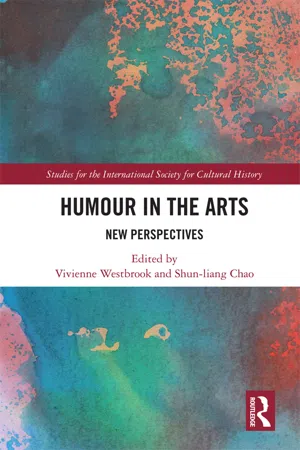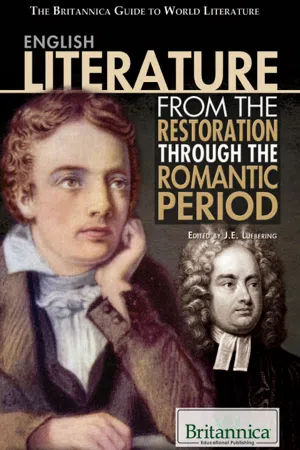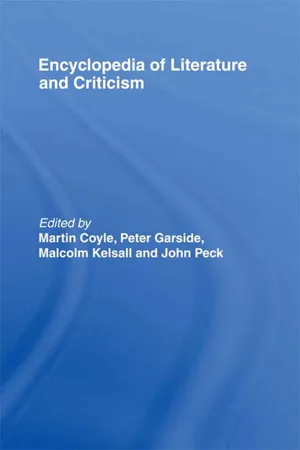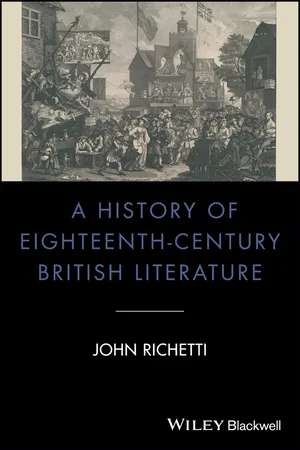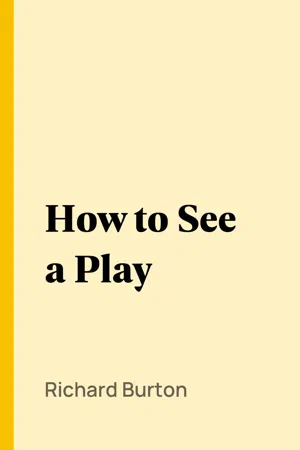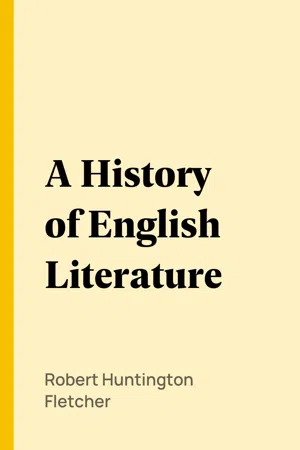Literature
Restoration Comedy
Restoration Comedy refers to a style of drama that was popular in England during the late 17th century. It is characterized by its witty dialogue, satirical portrayal of social manners, and often risqué themes. The plays typically featured complex plots, mistaken identities, and a focus on the foibles of the upper class. Notable playwrights of this genre include William Wycherley, William Congreve, and George Etherege.
Written by Perlego with AI-assistance
Related key terms
Related key terms
1 of 4
Related key terms
1 of 3
9 Key excerpts on "Restoration Comedy"
- eBook - ePub
Humour in the Arts
New Perspectives
- Vivienne Westbrook, Shun-liang Chao(Authors)
- 2018(Publication Date)
- Routledge(Publisher)
3 With the drive to make English theatre ever more appealing, Charles II warned the two company managers to avoid “profanation and scurrility” in their offerings, specifically advising Davenant to build a new theatre in order to stage “tragedies, comedies, plays, operas, musick, scenes and all other entertainments of the stage” (P.R.O, C66/3009, no. 3), thereby marking a distinct development in theatrical genres of the period. Davenant’s theatrical patent contained a contentiously liberal desire in its request relating to women: “We do likewise permit and give leave that all the women’s parts to be acting in either of the said two companies for the time to come may be performed by women” (Donohue 2005, 5). The promotion of a more elaborate, experimental, and inclusive theatrical environment, stemmed from Charles II’s exposure to innovative and elaborate productions during his exile in France and the Hague. During the Restoration period, both comedies and tragedies were staged in large numbers. Operatic and musical entertainments were subsequently introduced as spectator demands and tastes were developing. However, surprisingly, the popularity of comedies in this period was short lived, having enjoyed great success in the periods from 1660–1680 and during the 1690s (Corman 2013, xi).Theory and Comedy in the Restoration
Comedy writing and performance in this period drew upon a wealth of past knowledge to develop a range of comedic genres and devices as a means of entertaining the new Restoration audience.4 Restoration playwrights were probably familiar with the superiority theory of humour as it was promulgated by Plato and Aristotle, and later refined by Thomas Hobbes in his major work Leviathan (1651). Hobbes encouraged readers to learn from “the most able” and “free others from scorn” instead of laughing at the deformities of others, “a sign of pusillanimity,” whereas his view of humour permeated the theatre and plays of the period.The Restoration is perhaps best known for its inclination to mock and laugh at others through “comedy of manners.” As Paul Kuritz (1988) has noted,Each play juxtaposes the social appearance of purity and innocence with the personal truth of impropriety and promiscuity; apparent intelligence, with real ignorance; and seeming wealth, with actual poverty. City life is presented as fashionable; country life, as crude. Urban wit always outsmarts rural naivety. City people are civil, country people are naturally rude.(226)At the centre of such comic plays lay the ludicrous violation of social norms and cultural codes, along with sexually explicit and inappropriate behaviour. Notably, with the introduction of women to the stage, such acts became ever saucier. During his time in France, Charles II and his followers had unlimited access to French tragicomedy, then a dominant genre (Maguire 2000, 88), and presumably would have enjoyed the works of European playwrights and musicians—such as Molière (the pen name of Jean-Baptiste Poquelin 1622–1673), Pierre Corneille, and Louis Grabu—who would understandably become a major influence on English playwrights and the theatrical genres of the 1600s. Amongst them, Molière stood out, a man who, through his comedy of manners plays, particularly questioned the older theories of comedy by portraying characters who failed to conform to the rules set out by the likes of Aristotle and Horace (Calder 1993, 2–3). Writing comedies to explicitly reflect rather than merely assimilate real life, Molière attacked the upper classes specifically. His impact on English playwrights was deep and wide: “A stock of translations/adaptations [of Molière’s works]” as Robert D. Hume (2005) notes, “reached the stage, most of them decidedly farcical,” demonstrating a growing trend for farce in popular performance. (61) A good example is William Wycheley’s The Country Wife - eBook - ePub
- David L. Hirst(Author)
- 2017(Publication Date)
- Routledge(Publisher)
2The seventeenth centuryI will believe, there are now in the world Good–natured friends, who are not prostitutes, And handsome women worthy to be friends: Yet, for my sake, let no one e’er confideIn tears, or oaths, in love, or friend untried.(William Wycherley: The Plain Dealer, 1676)The terms Restoration Comedy and comedy of manners have become virtually synonymous; but in the twentieth century both require careful reconsideration. The comedy of manners is a dramatic genre which has continued in England to the present day; Restoration Comedy has always been a curious misnomer: Charles II came to the throne in 1660, and to describe all the comedies of the next fifty years as ‘Restoration’ is meaningless. The term is perhaps meaningful when considering those plays written during Charles’s reign, but to apply it to the dramas produced under James II, William and Mary and Queen Anne, whose political policies and life–style differed greatly, is absurd. Certainly the comedies written in these five decades have much in common which distinguished them from the Jacobean and early Caroline drama on the one hand and the plays of the later eighteenth century on the other. But it is equally instructive to observe that the plays of Farquhar, for example (the last two written in 1706 and 1707), have as much in common with She Stoops to Conquer as The Country Wife and indeed are much closer to Goldsmith’s drama than to the plays of Sheridan, who is usually distinguished as the prime exponent of comedy of manners in the late eighteenth century. This chapter will examine the major comedies of the late seventeenth century, drawing attention to the recurrent themes which serve to classify them as a distinct dramatic genre, whilst also emphasizing the differences between the plays of dramatists working under different social and political conditions.When the theatres reopened in England after the Restoration a distinct break in dramatic tradition and presentation had taken place. These theatres, at first only two — under the management of D’Avenant and Killigrew at Dorset Garden and Drury Lane respectively — were licensed by royal monopoly. They were much smaller than playhouses like the Globe and Swan, more on the model of the indoor Blackfriars, catering for an educated and wealthy aristocratic elite. The intimacy of the smaller indoor theatre with its proscenium and the beginnings of perspective scenery on grooved flats was a far cry from the Elizabethan outdoor public playhouse which had entertained an entire cross–section of the society of London. Shakespeare’s theatre with its bare stage reflected the diversity and grandeur of Renaissance life; the Restoration playhouse represented only a few scenes: notably the coffee house, the drawingroom and the park, which defined and circumscribed the range of social behaviour examined by the dramatists. Restoration England was not an heroic age, in its accomplishments offstage or on. In France Corneille’s tragicomedies and Racine’s tragedies were the perfect reflection of that tension between passion and intellect seen in the thought and action, both social and political, of Louis XIV’s court and country. - Britannica Educational Publishing, J.E. Luebering(Authors)
- 2010(Publication Date)
- Britannica Educational Publishing(Publisher)
CHAPTER 1RESTORATION LITERATURET he term Restoration literature refers to literature written after the Restoration of the English monarchy in 1660. Many of the literary forms considered typical of the modern world—including the novel, biography, history, travel writing, and journalism—were either invented or reached maturity in the late 17th century. Writers in all of these forms gained confidence, and wider readerships, during the Restoration period, when new scientific discoveries and philosophical concepts, as well as new social and economic conditions, came into play. There was a great outpouring of pamphlet literature, too, much of it politico-religious, while John Bunyan’s great allegory, Pilgrim’s Progress , also belongs to this period. Much of the best poetry, notably that of John Dryden (the great literary figure of his time, in both poetry and prose), was satirical and led directly to the later achievements of Alexander Pope, Jonathan Swift, and John Gay in the 18th century. The Restoration period was, above all, a great age of drama. Heroic plays, influenced by principles of French Neoclassicism, enjoyed a vogue, but the age is chiefly remembered for its glittering, critical comedies of manners by such playwrights as George Etherege, William Wycherley, Sir John Vanbrugh, and William Congreve.For some, the restoration of King Charles II in 1660 led to a painful revaluation of the political hopes and millenarian expectations bred during two decades that witnessed the violence and disorder of the English Civil Wars (1642–51) and the subsequent emergence of republican government under Oliver Cromwell. For others, it excited the desire to celebrate kingship and even to turn the events of the new reign into signs of a divinely ordained scheme of things. Violent political conflict may have ceased, but the division between royalists and republicans still ran through literature of the period. Indeed, it is hard to conceive of a single literary culture that could include, on the one hand, Bunyan and John Milton and, on the other, Dryden and John Wilmot, earl of Rochester. Yet these and other such opposites were writing at the same time.- eBook - ePub
- Martin Coyle, Peter Garside, Malcolm Kelsall, John Peck(Authors)
- 2002(Publication Date)
- Routledge(Publisher)
Although studies of Restoration drama based on very partial reading of the available evidence continue to appear, the growing tendency for serious scholars to base their work on total coverage of the period means that in the last two decades virtually all the received commonplaces about the subject have been discredited or questioned. The form that we know as the ‘Comedy of Manners’ was not the sole or even the dominant type of comedy. Nor is it true that Restoration Comedy habitually glamorizes successful rakes: comedy which cheerfully portrays and endorses extra-marital sex does not appear until the early 1670s, and although such plays then continue to appear until the mid-1690s, the real boom in sex comedy was located in the years 1672–82. Even here harsh criticism of the predatory rake can easily be found (e.g. in Otway’s Friendship in Fashion, 1678, Nathaniel Lee’s The Princess of Cleve, ?1680, and some of Durfey’s plays). Although Aphra Behn champions adultery as the refuge of the oppressed wife, she naturally condemns the predatory and domineering instincts of the male, which darken even many of her most sympathetically portrayed liaisons. Etherege’s Dorimant and Wycherley’s Horner are exceptional, not typical, creations. It is also untrue that the audience of Restoration drama was predominantly a court coterie audience. The Duke’s Company seems from the outset, even in the location of its theatres, to have sought the patronage of city audiences, and Harold Love (1980) has offered the rough guess that ten to fifteen percent of the available public (that is, excluding children, pregnant women, shopkeepers, etc.) may have attended the theatre in any year - John Richetti(Author)
- 2017(Publication Date)
- Wiley-Blackwell(Publisher)
To consider some typical samples of the varieties of Restoration Comedy, I will look briefly at some features of a number of popular works: Dryden’s Marriage a‐la‐Mode (1673) and his Amphitryon (1690), William Wycherley’s (1640–1716) The Country Wife (1675), George Etherege’s (1636–92) The Man of Mode; or Sir Fopling Flutter (1676), John Vanbrugh’s (1664–1726) The Provok’d Wife (1697), and William Congreve’s (1670–1729) The Way of the World (1700). 2 In my discussion of the Restoration stage, I will be mining the plays I have cited for styles and themes without claiming to offer anything like a complete description or analysis of any of them, since my effort is to trace the continuities and divergences in dramatic literature and performance in the eighteenth‐century English theater. It is also worth noting that many Restoration plays, comedies as well as tragedies, retained their popularity and were often revived during the eighteenth century. For example, Congreve’s masterpiece, The Way of the World, had almost three hundred performances into the 1790s. I suspect that for most twenty‐first‐century readers, Restoration heroic tragedy is a virtually unreadable or hilarious curiosity, its popularity in its time something of a puzzle. As far as I can tell, most of these plays were rarely – with several exceptions I have already mentioned, Southerne’s Oroonoko, Lee’s The Rival Queens, and Otway’s Venice Preserv’d – or indeed never revived after the eighteenth century or early nineteenth century, which is decidedly not the case with some Restoration comedies, some of which, Congreve’s and Wycherley’s especially, are often nowadays revived and assigned to be read in dramatic literature classes. Each of the four heroic tragedies I have cited is in the reading more like grand opera seria (without the music) in its extravagance, its bombastic and unconvincing (at least nowadays), extreme and exaggerated notions of character, sentiment, and action- eBook - ePub
- Richard Burton(Author)
- 2010(Publication Date)
- Perlego(Publisher)
[A] ; and yet will recognize that the Stratford man walked commonly on the heights only now and again touched by the others. And as he reads further the plays of dramatists like Massinger, Tourneur, Shirley, and Otway he will find, along with gleams and glimpses of the grand manner, a steady degeneration from high poetry and tragic seriousness to rant, bombast, and the pseudo-poetry that is rhetoric, with the declension of tragedy into melodrama. High poetry gradually disintegrates, and the way is prepared for the Restoration Comedy.Passage contains an image
In reflecting upon the effect of a closing of the public theaters for nearly twenty years (1642-1660) the student will appreciate what a body blow this must have been to the true interests of the stage; and find in it at least a partial explanation of the rebound to the vigorous indecencies of Congreve and his associates (Wycherley, Etherage, Vanbrugh, Farquhar) when the ban was removed; human nature, pushed too far, ever expressing itself by reactions.The ineradicable and undeniable literary virtues of the Restoration writers and their technical advancement of the play as a form and a faithful mirror of one phase of English society will reconcile the investigator to a picture of life in which every man is a rake or cuckold and every woman a light o' love; a sort of boudoir atmosphere that has a tainted perfume removing it far from the morning freshness of the Elizabethans. And consequently he will experience all the more gratitude in reaching the eighteenth century plays: The School for Scandal, The Rivals, and She Stoops to Conquer, when they came a generation later. While retaining the polish and the easy carriage of good society, these dramas got rid of the smut and the smirch, and added a flavor of hearty English fun and a saner conception of social life; a drama rooted firmly in the fidelities instead of the unfaithfulnesses of human character. These eighteenth century plays, like those of the Restoration—The Plain Dealer, The Way of the World, The Man of Mode, The Relapse, and The Beaux Stratagem—were still played in the old-fashioned playhouses, like Drury Lane, or Covent Garden, with the stage protruding into the auditorium and the classic architecture ill adapted to acoustics, and the boxes so arranged as to favor aristocratic occupants rather than in the interests of the play itself. The frequent change of scene, the five-act division of form, the prologue and epilogue and the free use of such devices as the soliloquy and aside remind us of the subsequent advance in technic. These marks of a by-gone fashion we are glad to overlook or accept, in view of the essential dramatic values and permanent contribution to letters which Sheridan and Goldsmith made to English comedy. But at the same time it is only common sense to felicitate ourselves that these methods of the past have been outgrown, and better methods substituted. And we shall never appreciate eighteenth century play-making to the full until we understand that the authors wrote in protest against a sickly sort of unnatural sentimentality, mawkish and untrue to life, which had become fashionable on the English stage in the hands of Foote, Colman and others. Sheridan brought back common sense and Goldsmith dared to introduce "low" characters and laughed out of acceptance the conventional separation of the socially high and humble in English life. His preface to The Good Natured Man - eBook - ePub
A Nation of Change and Novelty
Radical Politics, Religion and Literature in Seventeenth-Century England
- Christopher Hill(Author)
- 2023(Publication Date)
- Routledge(Publisher)
‘One function of the heroic romance seems to have been to assuage the guilt of the post-war generation over its abandonment of the legitimate monarch.’ 23 The society was ‘purposefully retreating from serious political engagement’, adds Martin Butler. ‘There was much going on in the drama before 1640 which would find no place on the stage after 1660.’ 24 The heroic was no longer plausible in the real world. The royalist gentry and aristocracy had come back, and they were very visible at court; but in comparison with the years before 1640 they had lost much of their automatic monopoly of positions of political importance. City money now talked. 25 Restoration Comedy attacks both bourgeois Puritan hypocrisy and traditional patriarchy, marriage for estates if not for money. The profound flippancy of this comedy relates to the irreverence of the revolutionary decades as well as to post-restoration cynicism. The literature is full of echoes of earlier irreligion and social subversion. The radical John Webster suggested that the Bible had been mistranslated in order to maintain belief in witchcraft. 26 Hobbes contributed to such attitudes; but they would have been unthinkable without the interregnum discussions. Whether the libertine ideas of Restoration Comedy come from the Ranters, from Hobbes, from ‘French influences’ or from an older English tradition 27 - these are unanswerable questions. I am not trying to draw pedigrees: once ideas are about, especially in print, they are free for all to exploit. Libertine ideas were by no means limited to radicals. 20 N. Maguire, ‘The “whole truth” of restoration tragicomedy’, in N. Maguire (ed.) Renaissance Tragicomedy: Explorations in Genre and Politics, New York, 1987, p. 222. 21 Catherine Belsey, ‘Tragedy, justice and the subject’, in P. Barker et al. (eds) 1642: Literature and Power in the Seventeenth Century, Essex University, 1981, passim. 22 Maguire, ‘Whole truth’, op cit., p - eBook - ePub
Memory and Enlightenment
Cultural Afterlives of the Long Eighteenth Century
- James Ward(Author)
- 2018(Publication Date)
- Palgrave Macmillan(Publisher)
as discussed in the following chapter, is a concern to present crime, punishment and their relation to social class in ways that refute the representation of these issues in the extant canon of fiction and drama. Lady Are comments on her securing a pardon that Bob ‘shall be reprieved at the tree […] [a]s in the old romances’ (259) and adds that the whole episode has ‘made an old lady merry with a farce’. A living link to the historic Restoration, this character is aware that she inhabits a dramatic ‘situation’ as well as an historical one, and recognizes that both are shaped and bounded by generic conventions. Her efforts to manipulate them, like her son’s manipulation of the corpse of his wife, present an allegory of the limits of historical memory and the power of determinants in shaping the past in the present.Victory and Restoration use the immediate and extended aftermath of monarchy’s return to interrogate and ironize the concept of restoration . In compact, episodic, narratives they present the political cataclysm of the seventeenth century as an analogue for the early 1980s, an apparently novel political dispensation which in a longer view resembles history repeating itself as both tragedy and farce. Each play also reawakens memories of the post-revolutionary period in order to destabilize a familiar and prevailing cultural memory of the post-1660 era as a proto-modern moment of tolerance, interclass harmony, and sexual enlightenment . Neither play, however, offers the revolutionary period as a positive countermemory. Victory depicts a Restoration which merely continues the brutality and carnage of the revolution while in Restoration , despite being only a generation old, the revolution is absent from characters’ memory. Genuinely revolutionary change is instigated under the guise of continuity through the alliance of aristocracy with finance capitalism, embodied in Victory though Charles II and Hambro and in Restoration through Hardache’s deal with Lord Are. This union replaces the marriage of lead characters central to the comic drama with which the period is associated, and provides a memory-equivalent to the new right’s marriage of fiscal radicalism and social conservatism in the 1980s. In spite of their differences both plays establish this alliance as a primary object of memory through which the represented past conditions the present. Beginning a shift away from the politics of nation and class and towards ‘notions of identity, gender and the limits of permissible social behaviour’, which as Ingo Berensmeyer asserts, became a major concern of Restoration memory texts in the 1990s, Restoration and Sexing the Cherry mark a transitional point in Restoration memory.42 - eBook - ePub
- Robert Huntington Fletcher(Author)
- 2005(Publication Date)
- Perlego(Publisher)
THE OTHER DRAMATISTS. The other dramatists of the Restoration period may be dismissed with a few words. In tragedy the overdrawn but powerful plays of Thomas Otway, a man of short and pathetic life, and of Nathaniel Lee, are alone of any importance. In comedy, during the first part of the period, stand Sir George Etherege and William Wycherley. The latter's 'Country Wife' has been called the most heartless play ever written. To the next generation and the end of the period (or rather of the Restoration literature, which actually lasted somewhat beyond 1700), belong William Congreve, a master of sparkling wit, Sir John Vanbrugh, and George Farquhar. So corrupt a form of writing as the Restoration Comedy could not continue to flaunt itself indefinitely. The growing indignation was voiced from time to time in published protests, of which the last, in 1698, was the over-zealous but powerful 'Short View of the Immorality and Profaneness of the English Stage' by Jeremy Collier, which carried the more weight because the author was not a Puritan but a High-Church bishop and partisan of the Stuarts. Partly as a result of such attacks and partly by the natural course of events the pendulum, by the end of the period, was swinging back, and not long thereafter Restoration Comedy died and the stage was left free for more decent, though, as it proved, not for greater, productions.CHAPTER IX
PERIOD VII. THE EIGHTEENTH CENTURY. PSEUDO-CLASSICISM AND THE BEGINNINGS OF MODERN ROMANTICISM [Footnote: Thackeray's 'Henry Esmond' is the greatest historical novel relating to the early eighteenth century.]POLITICAL CONDITIONS. During the first part of the eighteenth century the direct connection between politics and literature was closer than at any previous period of English life; for the practical spirit of the previous generation continued to prevail, so that the chief writers were very ready to concern themselves with the affairs of State, and in the uncertain strife of parties ministers were glad to enlist their aid. On the death of King William in 1702, Anne, sister of his wife Queen Mary and daughter of James II, became Queen. Unlike King William she was a Tory and at first filled offices with members of that party. But the English campaigns under the Duke of Marlborough against Louis XIV were supported by the Whigs, [Footnote: The Tories were the political ancestors of the present-day Conservatives; the Whigs of the Liberals.] who therefore gradually regained control, and in 1708 the Queen had to submit to a Whig ministry. She succeeded in ousting them in 1710, and a Tory cabinet was formed by Henry Harley (afterwards Earl of Oxford) and Henry St. John (afterwards Viscount Bolingbroke). On the death of Anne in 1714 Bolingbroke, with other Tories, was intriguing for a second restoration of the Stuarts in the person of the son of James II (the 'Old Pretender'). But the nation decided for a Protestant German prince, a descendant of James I through his daughter Elizabeth, [Footnote: The subject of Wotton's fine poem, above, p. 158.] and this prince was crowned as George I—an event which brought England peace at the price of a century of rule by an unenlightened and sordid foreign dynasty. The Tories were violently turned out of office; Oxford was imprisoned, and Bolingbroke, having fled to the Pretender, was declared a traitor. Ten years later he was allowed to come back and attempted to oppose Robert Walpole, the Whig statesman who for twenty years governed England in the name of the first two Georges; but in the upshot Bolingbroke was again obliged to retire to France. How closely these events were connected with the fortunes of the foremost authors we shall see as we proceed.
Index pages curate the most relevant extracts from our library of academic textbooks. They’ve been created using an in-house natural language model (NLM), each adding context and meaning to key research topics.
Explore more topic indexes
Explore more topic indexes
1 of 6
Explore more topic indexes
1 of 4
